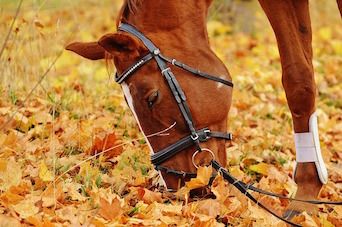A Promising Tool for Assessing Positive and Negative Emotions in Horses
The Qualitative Behavioral Assessment shows promise as a method of evaluating a range of positive and negative emotions in horses.

Although challenging, emotional assessment is an important component of animal welfare evaluations. Traditionally, animal emotional assessment has been conducted with behavioral, physiological, or cognitive methodologies. Qualitative Behavioral Assessment (QBA) takes a more holistic approach by evaluating how an animal expresses itself when actively interacting with its environment.
QBA has been studied in different species and in different contexts. For example, in horses, it has been used to evaluate responsiveness to human handlers. In the real world, QBA is used to complement on-farm animal welfare protocols like Welfare Quality. Importantly, QBA assumes a human observer can describe an animal’s behavioral expression in terms that reflect the animal’s emotion.
Notably, previous studies have reported this assessment tool’s strong correlation with physiological stress parameters and quantitative behavioral measurements. To date, though, few studies have tested QBA’s ability to assess experimentally-induced emotional states in animals.
RELATED:
- WVC 2017: Pain Control for the Aging Horse
- Welfare Quality and Stress in Working, Breeding Horses
The current study’s results, recently published in Applied Animal Behavior Science, suggest QBA’s promise in complementing animal welfare assessments that evaluate positive and negative emotional states.
Emotion Analysis
Sixteen horses (15 stallions, 1 mare), aged 3 to 20 years, received 4 short-term positive and negative treatments:
Positive treatments
- Grooming (G)
- Food anticipation (FA): access to a tasty reward after a 60-second wait
Negative treatments
- Plastic bag (PB) waved for 60 seconds to induce fear
- Food competition (FC): study horse fed last after neighboring horses
A grooming control treatment (Gcon; grooming movements, but no touching) was included to control for the experimenter’s presence.
Fifteen female veterinary students ("observers") with horse experience analyzed video recordings of the treatment sessions, then generated terms describing the horses’ behavioral expressions; observers were blind to treatment. Researchers then performed several data analyses to group the terms into 3 emotional dimensions accounting for most of the inter-horse emotional variation:
- Dimension 1 (D1): calm/content to nervous/stressed
- Dimension 2 (D2): irritated/angry to frightened/insecure
- Dimension 3 (D2): curious/interested to aggressive/irritated
Results
With 137 generated terms, researchers noted a general semantic consensus between the observers.
Treatment type significantly affected each emotional dimension. For example, PB treatment elicited strong negative emotions in D1 (stressed/nervous) and D2 (frightened/insecure). Interestingly, FA treatment produced positive emotions in D3 (curious/interested) and negative emotions in D2 (irritated/angry). Researchers supposed that individual horses may have transitioned from curious to irritated with FA treatment because the anticipation was too long.
Somewhat unexpectedly, there was little observed emotional variation between G and Gcon. Researchers proposed several explanations for this finding: (1) the low levels of emotional arousal with G and Gcon appeared very similar, and (2) the experimental design didn’t allow for statistical significance of subtle emotional variations.
Across all 3 dimensions, within-treatment variation of emotional states was greatest with FC. For this treatment, the neighboring horses also competed for food, potentially leading to wide emotional variation in the study horses.
Bringing it Together
The researchers concluded that the treatment-blind observers similarly judged the horses’ behavioral expressions, and that these judgements could differentiate between the negative and positive emotional treatments. Such conclusions lend more support to QBA’s previously-demonstrated validity.
Overall, this study’s findings “might be relevant for horse-human interactions in which an immediate assessment of a horse’s emotional state is important,” the researchers wrote.
Dr. JoAnna Pendergrass received her Doctor of Veterinary Medicine degree from the Virginia-Maryland College of Veterinary Medicine. Following veterinary school, she completed a postdoctoral fellowship at Emory University’s Yerkes National Primate Research Center. Dr. Pendergrass is the founder and owner of JPen Communications, a medical communications company.